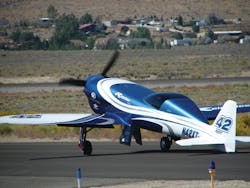Reno. Nineteenth-century boom town. Gambling mecca. The biggest little city in the world. And host city for the only pylon air racing in the world. Every September, at Stead Field, just over a hundred of the world’s most “Type-A” pilots and some of the best crews in motorsport gather to go faster than anyone else. With six classes and a week of qualifying and racing, the courses are vacated only briefly – and in the interval, top airshow performers keep everyone looking skyward.
Since virtually all the racers are flying under some sort of experimental clearance, innovation is key. Without taking anything away from the determination and skill of the pilots, he who innovates best has the best chance of winning. Rules constrain some innovation; but the rules apply to everyone in the class, so each team tries to tweak its airplane to the top of the chart.
The challenges of wrenching at Reno exceed the imagination of most who haven’t been in combat support. Not only is routine maintenance of unique machines difficult and often unorthodox, it must be performed with tight precision and often with no guidelines, as it is not uncommon to fabricate and test entirely new ideas during race week.
Although many of the T-6s and biplanes fly regularly, many others, in Sport, Formula One, Jet, and Unlimited classes fly only rarely; some are in one piece, literally, only a few weeks in the year. This doubles the load on mechanics, some of whom may never have seen the airplane in this year’s configuration. (And sometimes, the modifications don’t fit, or don’t work!)
Mistakes are extremely rare, given the mix of wrench-turners and proficiency levels; by week’s end, things are running smoothly. But of course, by then it’s time to get cleaned up for the banquet.
Not your ordinary aircraft maintenance job
The challenges of Reno are unique to aircraft mechanics. The closest parallel for a mechanic would be to top-echelon auto racing, but few mechanics cross from one arena to another. Further, in auto racing, there is a lot more track time, and there are multiple races in any series. In Reno racing, there’s only… Reno.
Slight misunderstandings, occurring from unfamiliarity, fatigue, or misinterpretation, result in expensive problems. Early one morning, I encountered an Unlimited flyer, who was upset with himself. He had asked the crew to “check” the spark plugs the night before, and they did, taking nearly the whole night to do it; they, however, didn’t “check” the plugs; they replaced them. No big deal, usually, but this was on a 4,360-inch, 28-cylinder P&W, and a set of plugs cost upward of $2,000. (He finished second in Gold.)
Other mistakes are dangerous. One normal midweek afternoon, we all heard and felt a loud explosion. Looking for smoke or some other clue was fruitless, but the cause of the noise was soon obvious: a Mustang sat very low on its gear, its back broken. New rules were in place that year, and someone (no one ever would say who) overfilled the Mustang’s air tank. By a lot. No one was hurt, but the rules changed again, after that.
For mechanics who are used to working alone and at their own pace, Reno is a different world. Everyone on a team helps wherever possible. Sometimes, curious and helpful spectators are called on to assist in, say, a smaller-class engine change, or to go find parts or a tool. “Crew management” is as important as raw knowledge; those volunteers are a force multiplier, but also, as one crew chief said, “must be watched.”
Sometimes, the press of time can overwhelm judgment, skill, and the airman’s last defense, luck. Improper design, bad assumptions (like “I thought you did that”) have led to some mechanical and human disasters.
Because of the litigation involved and my position as a trusted journalist who wants to continue his welcome by the teams, citing specific examples here is not wise, but mistakes that might be survivable in regular flying might not be, at speed over the Nevada desert. Loose control cables; using the wrong material when the right one wasn’t available; designing a “push on a rope” method of trim actuation; using worn-out fasteners; ignoring an unidentified vibration in the interest of getting a chance to “test” – all these have badly scared or even killed racers in the past few years.
Always, the insidious demon of fatigue is working to overcome the angel of adrenaline. Fatigue always wins, in the end. Checking, by pros and apprentices alike, is encouraged. Any question is answered; any doubt addressed. No one, no matter how confident he is in anyone’s abilities, neglects this oversight.
Still, making things more interesting and sometimes easier is the idea that pervades the races: “If it’s safe and it works, do it!” Material substitutions, prop swaps, all sorts of loaned parts and scrounged parts are mixed with the original, as the week progresses or as things don’t meet expectations. Modifications – a complete new air intake, new cylinders, trim, gear door springs – anything that makes the airplane safer and faster, goes in.
What does it take to wrench at Reno?
There are very few paid positions on teams at the races. Many of the top teams rely on a devoted set of volunteers, some of whom work all year on the airplane; others come just for the race, or the Pylon Racing School (known as “Rookie School”) in June. A few are in the right place at the right time (like when an engine is getting changed, manually and without any kind of lift) in the F 1 pits. Some of these people end up affiliated with the team for the rest of the week; some become annual assets, planning their vacations around Race Week.
Holding an A&P certificate is always beneficial, but at Reno it’s not always necessary and in some cases, it wouldn’t even help. Hot-rodding experience, however, and fabrication experience (especially in welding, sheet, and composite) are always appreciated. Painters (and fillers and sanders), go-fers, and coffee makers, too, can often find an appreciative team.
Other qualities? As with any high-end racing, it’s good to be able to think on your feet, even when you’re so tired it’s hard to stand upright. It’s important to be agile and alert – airplanes are everywhere, and sometimes they can get out of control. Practicing yoga may help, too – some tasks require phenomenal balance and flexibility. But knowing how to out-swear a sailor or out-lie a politician isn’t appreciated – even with all the tension and testosterone, Reno’s a family place.
In fact, the ability to think and discuss clearly, to analyze and predict, to notice, question, and investigate – these may be the most-valuable assets any team member may bring to the table.
For those who haven’t been to Reno, but are regular attendees at other aviation events: Reno is different. Oshkosh may be the Detroit Auto Show; Reno is the Indianapolis 500. If you’ve never been to the Reno Air Races, go. With the added burden of astronomical insurance and more “attention” from the FAA and disdain from the NTSB; with encroaching development in the Stead valley, and with the added expenses of maintaining these aircraft, y’all can’t count on Reno to be there forever.
Go early – hotels are inexpensive before the official dates, and fast flying starts a week before the trophy races; and there are interesting things going on in the air all week – practice, qualifying, heat races. Bring sunscreen and three seasons of clothing, and lots of batteries for the camera. Official dates are Sept. 11-15, 2013, but come earlier if you can!
Find out more: www.airrace.org
Tim Kern has attended and reported on all the Reno races since the no-race year of 2001, and has done some light lifting on a number of teams in several classes.
About the Author

Tim Kern
Tim Kern is an aviation writer, aircraft builder, and private pilot. He is based in Anderson, IN, and can be reached at [email protected].
Tim Kern, CAM, MBA, has written for over 50 aviation publications, and is a consultant for a variety of companies; www.timkern.com.
